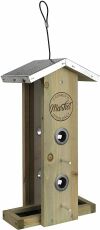
What’s This Post About?
Sparrows are amazing bird species that were first spotted in Brooklyn, New York, and then from there, they have spread to the Rocky Mountains, aiding the birds’ presence across the west. Now they are common throughout North America and some parts of northern Canada.
If you find yourself growing eager to learn about and observe sparrows in your backyard, you can install a flat tray feeder and place millet, milo, and sunflower seeds around for them to visit.
If you want to spot them elsewhere, away from your backyard, then just visit your local residential park with some leftovers.
No. Sparrows are not migratory birds. They are sedentary, which essentially means that they do not migrate and remain in the same place throughout the year since they thrive only in urban areas among the human population.

What Are Sparrows?
Sparrows are the most well-known and abundant bird species globally, with conical beaks and brown-colored plumage. They can be seen trotting around in urban residential spaces, especially parks, and some backyards, since they’re actively present in areas where humans are.

This is so because the birds have grown accustomed to eating food that people provide to them through bird feeders and giving them their starchy leftovers at parks and other places.
Due to this reason, sparrows are encouraged to go looking for places packed with humans.

| Common Name | Sparrows |
| Common Color | Brown (white cheeks and black bib) |
| Scientific Name | Passeridae |
| Average Weight | 24 – 40g |
| Average Size | 14 – 18 cm |
| Diet | Grains, seeds, livestock feed, discarded food |
| Average Lifespan | 3 years (in the wild) |
Fun Fact
Every year on March 20th, sparrow day is observed globally. The historical significance of this day was to raise awareness to protect house sparrows in most parts of the world
Sparrows And Their Surviving Techniques
Sparrows, just like many other birds, change their behavior during the winter season, which helps them survive the cold, harsh weather.

Almost every bird species migrate when the weather is changing, but those who don’t, they have their reasons. These birds protect themselves in several ways; for example, during winters, most birds who do not migrate have a way of keeping themselves warm.
Continue reading to find out how they do it.
Some sparrows migrate to northern and central North America during the winters, but those who stay back must take specific measures to remain warm. These measures include:
-
Changing their physical and behavioral adaptation
-
Fluffing
-
Constricting their blood vessels
-
Shivering
-
Sunbathing
Let’s take a deeper look at how sparrows survive when they don’t migrate in winters.
Physical and Behavioral Adaptation
Their feathers offer insulation which keeps them warm throughout the winters. In addition, it is said that these birds also grow some extra feathers to help them through the process of trapping the heat, keeping them warm during the season.

All non-migratory birds pack on extra weight during the summer in anticipation of the cold winter weather. This weight is mainly a thin layer of fat produced by their bodies to keep the heat from escaping their bodies.
Fluffing
Sparrows retain heat in their bodies, specifically in their core, by fluffing out their feathers, making them look like fluff balls.
This helps them create tiny pockets of air between their skin and feathers, which are then continually kept warm by the bird’s body. The more air they trap, the warmer they’ll feel.
Constricting Their Blood Vessels
Birds reduce heat loss during winters by constricting their blood vessels, but since it’s not a long-term fix, what they do is tuck one leg up at a time or fold their legs in a way that helps the feathers on their body cover their legs too.
Shivering
This short-term fix is what they opt for when the weather gets unbearably cold. But, unfortunately, this process requires a lot of energy which may tire out the bird.
Sunbathing

Birds love reaping the sun’s warmth. They do so by placing their backs towards the sun to soak up all the heat. This helps conserve their energy and body warmth because it doesn’t require them to use up their energy, keeping themselves warm since the sun does it for them.
Things You Can Do To Help Sparrows

When the temperatures start to get frigid, and it gets a lot chillier outside, it’s only natural for you to start worrying about these birds’ survival, especially if you want them to frequent your backyard even during the winters.
Wild birds are not well equipped to survive in the harsh winter weather since they do not have access to sheltered or heated spaces. If they are left out in the open without any assistance, there’s little chance of their survival.
How are you going to help these birds during this time around? Will you be giving them space to sleep? Will you be taking certain steps to make sure that they are comfortable coming to your backyard? If you’ve asked yourself the aforementioned questions, then continue to read on.
You can take quite a few steps to protect these birds during the winter, playing your part and being responsible to some extent.
Some of the ways you can assist sparrows in winter include:
-
Providing them with natural vegetation for shelter and nesting
-
Building birdhouses
-
Providing appropriate feeders
-
Providing the right feed
-
Providing them with enough water
Natural Shelter In Winters
You can easily help the birds by providing them with a shelter close to your house. The ideal way to go about providing them with natural cover is to plant trees and shrubs in and around your backyard. Of course, you could plant some trees outside your house too.
Doing so will ensure that sparrows have enough shelter space to hide in during the nighttime. Although there could be drawbacks to planting trees and bushes, as many predators can climb up the trees and hide well in the bushes, it still provides an excellent space for sparrows to roost.
Building Birdhouses
If you have a barn, garage, or space in your house, cardinals may fly into one of these to seek shelter and nest during winters. Sparrows usually look for empty spaces to settle in, and this is a phenomenon that occurs all year round and isn’t specific to winters only.
Therefore, you can help them find a safe space by building birdhouses or installing them in your backyard. Sparrows are at ease inside any enclosed space, including a birdhouse. In addition, the enclosed birdhouses help keep predators at bay.
Providing Appropriate Feeders
Provide them with correct bird feeders. Sparrows like to eat their food off flat surfaces and ledges.
You can explore the Wild Wings Hopper feeder for this purpose.
Wild Wings WWGF1-DECO Galvanized Weathered Vertical Cedar Bird Hopper Feeder
Weathered stain and a textured galvanized roof provide a decorative rustic feel to your birding experience!
This hopper will not only attract sparrows to your yard but will invite other backyard birds such as jays, cardinals, finches, among others.
Providing The Right Feed
Sparrows can eat almost about anything from grains to leftovers. Just make sure you’re giving them the right treats. They particularly love to eat millet, milo, sunflower seeds, birdseed mixes, and starchy leftovers.
So make sure you keep the feeders full throughout the day to keep these little birds full during the winter.
Different Ways You Can Attract Sparrows

Having sparrows frequent your backyard feeders is quite an experience. Their melodic, high-pitched chirps will fill your backyard and balcony with pleasant bird noises all day. If you enjoy their songs, you might want to invite them to your backyard more.
Sparrows aren’t shy or elusive like other backyard birds. They love following humans around because that’s how they get their food. You don’t even have to put in half the effort to attract them to your backyard.
They are just about everywhere, and people usually wish to get rid of them since they are so noisy when it’s time to feed them.
Other birds’ sounds and melodies are very often distorted due to this, which is why people do not wish to have them in their backyards. However, if that’s what you want, you can do a couple of things to invite them.
Sparrows aren’t fussy eaters. So you can offer them seeds and starchy crumbs strewn on the ground or feed them from a feeding dish placed on the ledge of your balcony or floor. This way, they’ll have enough feed to enjoy.
You can also explore the Wagners Bird Seeds which sparrows love to devour!
Wagner's Songbird Wild Bird Food
5-highly nutritious foods that will attract a wide variety of birds to your backyard
All you have to do to invite them to your backyard is provide them their favorite treats. Read more about how you can choose the right feeder for your backyard birds
How to Choose the Right Kind of Bird Feeder: Types, Location, Size, etc.
Are you here searching for a suitable bird feeder for your garden? Well, you're at the right place because here we will discuss various bird feeders.
You could perhaps offer them popcorn as a treat sometimes, but avoid giving them microwaved popcorn since the salt in prepackaged popcorn may be hazardous to birds.
Pro-Tip
Sparrows do not prefer eating from the feeders. Try investing in a flat tray feeder or just simply serve the food on the ground, on a flat surface.
However, be mindful of how much you feed them because these birds might end up swarming your backyard in large flocks. They are very social and prefer munching on food with their peers.

Keep Reading!
To sum it up, sparrows are not migratory birds. Instead, they are sedentary, which means they do not migrate and spend the entire year in the same location since they prefer living in urban areas near humans.
If you want to read more about birds and their migration patterns, here’s a blog that can add to your knowledge about migration preferences of cardinals.
Do Cardinals Migrate? You Won’t Believe It but It’s True!
Interested to learn more about cardinals and their migration plans? Read the post below for some interesting facts and information.

By David A. Swanson
Bird Watching USA
My name is David and I'm the the founder of Bird Watching USA! I started Bird Watching with My father-in-law many years ago, and I've become an addict to watching these beautiful creatures. I've learnt so much over about bird watching over the years that I want to share with the world everything I know about them!

David A. Swanson
Bird Watching USA
My name is David and I'm the the founder of Bird Watching USA! I started Bird Watching with My father-in-law many years ago, and I've become an addict to watching these beautiful creatures. I've learnt so much over about bird watching over the years that I want to share with the world everything I know about them!












